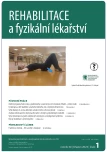The Franklin Method – body and movement in imagination
Authors:
Elblová Roth M.
Authors‘ workplace:
Hudební a taneční fakulta, Akademie múzických umění v Praze
Published in:
Rehabil. fyz. Lék., 30, 2023, No. 1, pp. 47-54.
Category:
Review Article
doi:
https://doi.org/10.48095/ccrhfl202347
Overview
The article aims to describe the discovery of images in the human body as a bearer of a new and healthy approach to movement. It looks at the issue through the principles, exercises and mental images of the Franklin Method (F-M), which simulate the movement of certain body structure, its movement quality and dynamics. The method uses specific exercises to prepare for physical performance or to regenerate and rehabilitate the body. By means of specific examples, I will outline how ideas and exercises can be grasped and how to work with them further and creatively within a certain movement sequence. I draw not only from professional dance practice, educational programs, and teaching F-M in the dance and outside the dance environment, but I also rely on knowledge, studies, and literature in the field of F-M, dynamic neuro-cognitive imagery and ideokinesis. Long-term practice with F-M techniques leads to understanding of the movement and functions of our body, in order to treat the body more gently, improve overall coordination, and, thus, optimize physical performance.
Keywords:
health – Creativity – Franklin Method – body – movement – ideas – images – coordination
Sources
1. Franklin EN. Frei bewegen: Mit der wissenschaftlich fundierten Franklin-Methode zu mehr Beweglichkeit und einer dynamisch perfekten Haltung. München: Riva 2020. ISBN 978-3-7423-1199-3.
2. Franklin EN. Conditioning for dance. Training for whole-body coordination and efficiency. Champaign: Human Kinetics 2019: 13. ISBN 978-1-4925-3363-4.
3. Bernard A, Stricker U, Steinmüller E. Ideokinese: Ein kreativer Weg zu Bewegung und Körperhaltung. Bern: Verlag Hans Huber 2011: 7. ISBN 978-3-456-85016-0.
4. Franklin EN, Schausberger M, Graf H. Hanbuch zur Ausbildung: Level 1. Gmunden und Obergrünzburg: Institut für Franklin-Methode 2019: 14–16.
5. Kulišťák P et al. Klinická neuropsychologie v praxi. Praha: Karolinum 2017. ISBN 978-80-246-3068-7.
6. Franklin EN. Franklin Method the inaternational, obrazové materiály, 2016.
7. Franklin EN. Tanz-Imagination: Stark im Ausdruck und perfekt in der Technik. Das Handbuch für Training und Bühne. VAK 2002. ISBN 3-932098-94-3.
8. Todd EM. The thinking body. USA: A Dance Horizons Book, Princeton Book Company, 1937. ISBN 87127-014-5.
9. Re-habilis.cz. PROPRIOCEPCE – Význam pro fyzioterapii a její změny u vybraných diagnóz. [online]. Dostupné z: http://www.re-habilis.cz/sites/default/files/Propriocepce_BLOG_2013.pdf.
10. Franklin EN. Befreite Körper: Das Handbuch zur Imaginativen Bewegungspädagogik. VAK Verlags 1999. ISBN 3-932098-26-9.
11. Calais-Germain B. Anatomie der Bewegung: Technik und Funktion des Körpers. Einführung in die Bewegungsanalyse. Wiesbaden: Marixverlag 2012. ISBN: 978-3-86539-038-7.
12. Franklin EN. Bewegung beginnt im Kopf: locker, leicht, dynamisch mit der Franklin-Methode. Kirchzarten bei Freiburg: VAK Verlags 2016. ISBN 978-3-86731-004-8.
13. Sweigard LE. Human movement potential: its ideokinetic facilitation. USA, Allegro Edition 1974. ISBN 978-1-62654-947-0.
14. Franklin E. Beckenboden Power: Das dynamische Training für sie und ihn. München: Kösel-Verlag 2002. ISBN 978-3-466-34458-1.
15. Schünke M, Schulte E, Schumacher U et al. Prometheus: Allegemeine Anatomie und Bewegungssystem. Stuttgart: Thieme Verlag 2005. ISBN 3-13-139521-4.
16. Simmel L. Tanzmedizin in der Praxis: Anatomie, Prävention, Trainingstipps. Leipzig: Henschel Verlag 2009. ISBN 978-3-89487-596-1.
17. Greene Haas J. Dance Anatomie: Der vollständig illustrierte Ratgeber für Beweglichkeit, Kraft und Muskelspannung im Tanz. München: Human Kinetics 2010.
18. Dylevský I. Somatologie pro předmět Základy anatomie a fyziologie člověka. 3. přeprac. a dopl. vyd. Praha: Grada Publishing 2019. ISBN 978-271-2111-3.
Labels
Physiotherapist, university degree Rehabilitation Sports medicineArticle was published in
Rehabilitation & Physical Medicine

2023 Issue 1
Most read in this issue
- Development of rehabilitation in the Czech Republic
- Physiotherapy in primary and lower-secondary school children with poor posture
- The Franklin Method – body and movement in imagination
- The effect of physiotherapy on the quality of motion patterns in impingement syndrome
